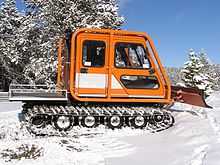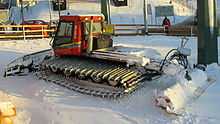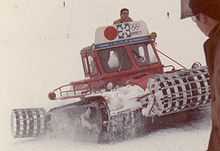Snow grooming




Snow grooming or piste bashing is the process to manipulate snow for recreational uses, usually using a snow groomer, also called a trail groomer or piste basher, and colloquially sometimes referred to as a "pistie beastie". This can be a tractor, snowmobile, piste caterpillar, truck or snowcat towing specialized equipment to move and manipulate snow. The process is used to maintain ski hills, cross country ski trails and snowmobile trails by grooming (moving, flattening, rototilling, or compacting) the snow on them.
Types
Groomers built for ski slopes are often different from those used to groom snowmobile trails. Groomers like American based Tucker Sno-Cat, the Canadian based Lamtrac and German based Pisten Bully and Prinoth formerly known as Bombardier in North America and Europe build different types of snowcats for different applications.
Several manufacturers of track conversions, build tractor based conversion groomers which are economical choices for snowmobile trail grooming. Because they are designed to pull agricultural equipment, the tractors adapt easily to pulling trail grooming drags. Modern groomers built for ski slopes employ front mounted, hydraulically operated blades, powered rotary tillers and specialized shaping equipment for not only maintaining ski slopes, but also for building half pipes, ski/snowboard terrain parks and snow tube parks. Cross country ski trails are also groomed in similar fashion, but use specialized drags that imprint ski guides instead of grooming a wide path suitable for high speed snowmobile use.
Process
A groomer will usually go out to pack the snow and improve skiing and snowboarding and snowmobile trail conditions. The resulting pattern on the snow is known as corduroy in ski and snowboard slang, and is widely regarded as a good surface on which to ski or ride. Snow groomers can also move snow made by snow machines. Groomers are mostly sent out during the night time after the close of the ski area so as not to interfere with daily and night skiing.[1]
Environmental effects
Snow grooming and the associated snow packing is known to have negative effects. The compaction reduces porosity, permeability and water holding capacity of the mountain slopes, while heat flow rates and length of snow retention are seen to increase. This combines to produce longer and deeper frost penetration into the soil, causing negative effects on the underlying tussock. It is suggested that the compacted areas be marked and shifted over time to reduce the ecological effects.[2]
See also
- Manufacturers
- Lamtrac
- Kässbohrer
- Prinoth
- Ratrak
- Bombardier
- Logan Machine Company
- Tucker Sno-Cat
- Snow Trac
- Thiokol
- Ohara Corporation / AZTEC
- Snow farming
- Snowcat
- Snowmobile
References
- ↑ Snowmakers, snowmaking prevail when Mother Nature is uncooperative - Pocahontas Times - Mountain Times, Vol. 6 No. 2 February 2007
- ↑ Likely impacts of snow grooming and related activities in the West Otago ski fields (PDF) - Fahey, Barry & Wardle, Kate; published by the New Zealand Department of Conservation, June 1998
External links
| Wikimedia Commons has media related to Snow groomer. |
- Grooming Talk
- Tråkkemaskin.no / Snow-groomer.net (webpage and photogallery related to snowgrooming)
- Koz's Snowgrooming Links (private webpage related to snow grooming)
- Prinoth (manufacturer of snow groomers and special vehicles)
- Pistenbully (manufacturer of snow groomers and special vehicles)
- Favero (manufacturer of small snow groomers and trailers)